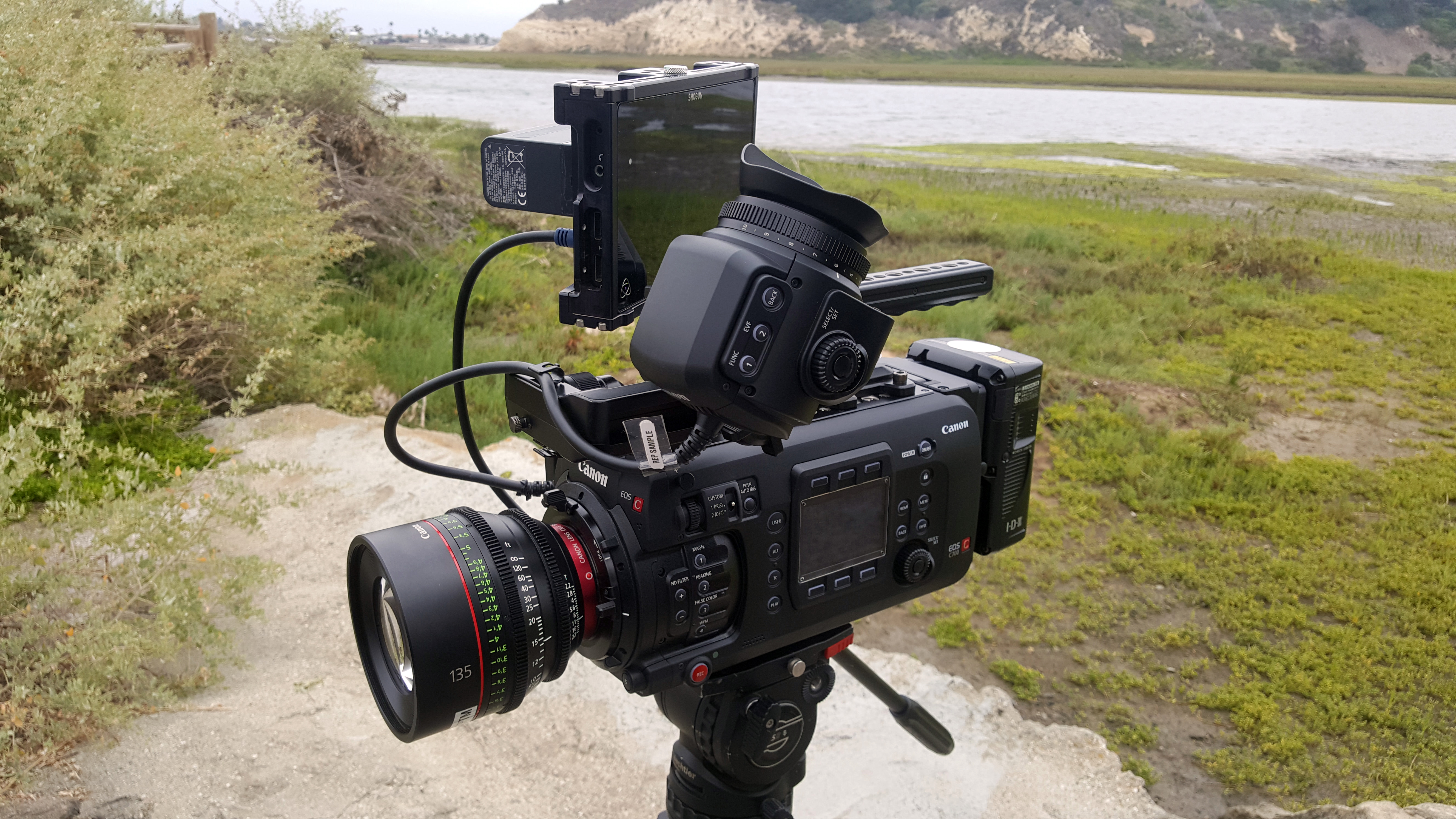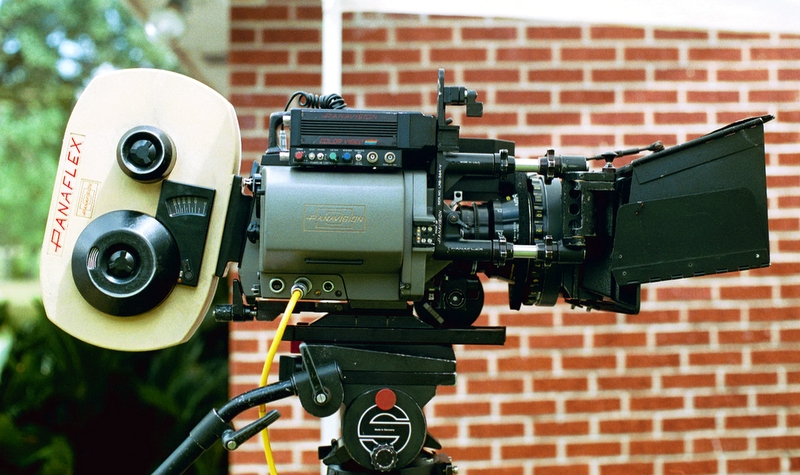|
Arriflex 35BL
The Arriflex 35BL is a 35mm motion picture camera released by ARRI in 1972. Function The Arriflex 35BL was the first silent 35mm camera (BL stands for blimped). It uses a fixed butterfly reflex shutter, which gave the cinematographer an exact representation of the recorded frame. It recorded up to 100 frames per second, which was revolutionary in documenting sporting events. It uses a dual registration pin system. It also has an odometer-styled analogue footage counter. The camera uses both and magazines. History The development of the 35BL began in 1966, since there was no handholdable, silent, reflex 35 mm camera at that time. The release of this camera, together with the Panaflex Lightweight released in 1975, changed the filmmaking process profoundly and made big camera setups like the Mitchell BNCR obsolete. The Arriflex 35BL was released just in time to document the 1972 Summer Olympics, in Arri's hometown Munich. This led to a huge boost in popularity of this camera. I ... [...More Info...] [...Related Items...] OR: [Wikipedia] [Google] [Baidu] |
35 Mm Movie Film
35 mm film is a film gauge used in filmmaking, and the film standard. In motion pictures that record on film, 35 mm is the most commonly used gauge. The name of the gauge is not a direct measurement, and refers to the nominal width of the 35 mm format photographic film, which consists of strips wide. The standard image exposure length on 35 mm for movies ("single-frame" format) is four perforations per frame along both edges, which results in 16 frames per foot of film. A variety of largely proprietary gauges were devised for the numerous camera and projection systems being developed independently in the late 19th century and early 20th century, as well as a variety of film feeding systems. This resulted in cameras, projectors, and other equipment having to be calibrated to each gauge. The 35 mm width, originally specified as inches, was introduced around 1890 by William Kennedy Dickson and Thomas Edison, using 120 film stock supplied by George Eastman. F ... [...More Info...] [...Related Items...] OR: [Wikipedia] [Google] [Baidu] |
Motion Picture Camera
A movie camera (also known as a film camera and cine-camera) is a type of photographic camera that rapidly takes a sequence of photographs, either on an image sensor or onto film stock, in order to produce a moving image to project onto a movie screen. In contrast to the still camera, which captures a single image at a time, by way of an intermittent mechanism, the movie camera takes a series of images; each image is a ''frame'' of film. The strips of frames are projected through a movie projector at a specific frame rate (number of frames per second) to show a moving picture. When projected at a given frame rate, the persistence of vision allows the eyes and brain of the viewer to merge the separate frames into a continuous moving picture. History An interesting forerunner to the movie camera was the machine invented by Francis Ronalds at the Kew Observatory in 1845. A photosensitive surface was drawn slowly past the aperture diaphragm of the camera by a clockwork mechanism ... [...More Info...] [...Related Items...] OR: [Wikipedia] [Google] [Baidu] |
ARRI
The Arri Group () is a German manufacturer of motion picture film equipment. Based in Munich, the company was founded in 1917. It produces professional motion picture cameras, lenses, lighting and post-production equipment. Hermann Simon mentioned this company in his book ''Hidden Champions of the 21st Century'' as an example of a " hidden champion". The Arri Alexa camera system was used to film Academy Award winners for Best Cinematography including ''Hugo'', ''Life of Pi'', ''Gravity'', '' Birdman'', '' The Revenant'' and '' 1917''. History Early history Arri was founded in Munich, Germany on 12 September 1917 by August Arnold and Robert Richter as Arnold & Richter Cine Technik. The acronym ''Arri'' was derived from the initial two letters of the founders' surnames, ''Ar''nold and ''Ri''chter. In 1924, Arnold and Richter developed their first film camera, the small and portable Kinarri 35. In 1937, Arri introduced the world's first reflex mirror shutter in the Arriflex 35 c ... [...More Info...] [...Related Items...] OR: [Wikipedia] [Google] [Baidu] |
Cinematographer
The cinematographer or director of photography (sometimes shortened to DP or DOP) is the person responsible for the photographing or recording of a film, television production, music video or other live action piece. The cinematographer is the chief of the camera and light crews working on such projects and would normally be responsible for making artistic and technical decisions related to the image and for selecting the camera, film stock, lenses, filters, etc. The study and practice of this field is referred to as cinematography. The cinematographer is a subordinate of the director, tasked with capturing a scene in accordance with director’s vision. Relations between the cinematographer and director vary. In some instances, the director will allow the cinematographer complete independence, while in others, the director allows little to none, even going so far as to specify exact camera placement and lens selection. Such a level of involvement is less common when the director ... [...More Info...] [...Related Items...] OR: [Wikipedia] [Google] [Baidu] |
Odometer
An odometer or odograph is an instrument used for measuring the distance traveled by a vehicle, such as a bicycle or car. The device may be electronic, mechanical, or a combination of the two (electromechanical). The noun derives from ancient Greek , ''hodómetron'', from , ''hodós'' ("path" or "gateway") and , ''métron'' ("measure"). Early forms of the odometer existed in the ancient Greco-Roman world as well as in ancient China. In countries using Imperial units or US customary units it is sometimes called a mileometer or milometer, the former name especially being prevalent in the United Kingdom and among members of the Commonwealth. History Classical Era Possibly the first evidence for the use of an odometer can be found in the works of the ancient Roman Pliny (NH 6. 61-62) and the ancient Greek Strabo (11.8.9). Both authors list the distances of routes traveled by Alexander the Great (r. 336-323 BC) as by his bematists Diognetus and Baeton. However, the high ac ... [...More Info...] [...Related Items...] OR: [Wikipedia] [Google] [Baidu] |
Camera Magazine
A camera magazine is a light-tight chamber or pair of chambers designed to hold film and move motion picture film stock before and after it has been exposed in the camera. In most movie cameras, the magazine is a removable piece of equipment. Many still photo cameras also have removable camera magazines. A film cartridge serves the same function, but is usually not reusable. Lengths In 16 mm filmmaking, most magazines are designed to accommodate up to 400 feet of film stock, which usually is the longest standard roll size available from film manufacturers (longer rolls can be made upon special request sometimes, but require special magazines). In 35mm filmmaking, there tend to be three common magazine types - 1000 foot magazines, which accommodate the longest standard roll size of 35 mm film; 400 foot magazines, which are often used when the camera is handheld in order to minimize the amount of weight upon the camera operator; and 400 foot Steadicam magazines, which are sp ... [...More Info...] [...Related Items...] OR: [Wikipedia] [Google] [Baidu] |
Reflex Camera
{{Unreferenced, date=July 2021 A reflex camera is a camera that permits the photographer to view the image that will be seen through the lens, and therefore to see exactly what will be captured, contrary to viewfinder cameras where the image could be significantly different from what will be captured. Variations A single-lens reflex camera typically uses a mirror and prism system (hence "reflex", from the mirror's reflection) to accomplish this. The mirrorless interchangeable-lens camera achieves the same result by providing the photographer with a digitally captured image. The twin-lens reflex camera provides both a viewfinder image by reflecting the image onto ground glass and an image through another lens to the film. The image exposing the film is not reflected. See also *single-lens reflex camera A single-lens reflex camera (SLR) is a camera that typically uses a mirror and prism system (hence "reflex" from the mirror's reflection) that permits the photographer to view ... [...More Info...] [...Related Items...] OR: [Wikipedia] [Google] [Baidu] |
Panaflex Camera
Panavision has been a manufacturer of cameras for the motion picture industry since the 1950s, beginning with anamorphic widescreen lenses. The lightweight Panaflex is credited with revolutionizing filmmaking. Other influential cameras include the Millennium XL and the digital video Genesis. Panavision Silent Reflex * Panavision Silent Reflex (1967) * Panavision Super PSR (R-200 or Super R-200) Panaflex ; Panaflex (1972): ; Panaflex-X (1974): ; Panaflex Lightweight (1975): The Panaflex Lightweight is a sync-sound 35 mm motion picture camera, stripped of all components not essential for work with "floating camera" systems such as the Steadicam. Contemporary cameras such as the Panavision Gold II can weigh as much as depending on configuration. The Panaflex Lightweight II (1993) is crystal-controlled in one-frame increments between four and 36 frames per second, and has a fixed focal-plane shutter. 200°, 180°, 172.8° or 144° shutters can be installed by Panavision prio ... [...More Info...] [...Related Items...] OR: [Wikipedia] [Google] [Baidu] |
Mitchell Camera
Mitchell Camera Corporation was a motion picture camera manufacturing company established in Los Angeles in 1919. It was a primary supplier of newsreel and movie cameras for decades, until its closure in 1979. History The Mitchell Camera Corporation was founded in 1919 by Americans Henry Boeger and George Alfred Mitchell as the National Motion Picture Repair Co. Its first camera was designed and patented by John E. Leonard in 1917, and from 1920 on, was known as the Mitchell Standard Studio Camera. Features included a planetary gear-driven variable shutter and a unique rack-over design . George Mitchell perfected and upgraded Leonard's original design, and went on to produce the most beloved and most universally used motion picture cameras of the Golden Age of Hollywood under the name of The Mitchell Camera Company. The company was first headquartered on Sunset Blvd in Los Angeles, then building a new factory in West Hollywood and moving there in 1930, and finally moving operati ... [...More Info...] [...Related Items...] OR: [Wikipedia] [Google] [Baidu] |
1972 Summer Olympics
The 1972 Summer Olympics (), officially known as the Games of the XX Olympiad () and commonly known as Munich 1972 (german: München 1972), was an international multi-sport event held in Munich, West Germany, from 26 August to 11 September 1972. The event was overshadowed by the Munich massacre in the second week, in which eleven Israeli athletes and coaches and a West German police officer at Olympic village were killed by Palestinian Black September members. The motivation for the attack was the ongoing Palestinian-Israeli conflict. The 1972 Summer Olympics were the second Summer Olympics to be held in Germany, after the 1936 Games in Berlin, which had taken place under the Nazi regime, and the most recent Olympics to be held in the country. The West German Government had been eager to have the Munich Olympics present a democratic and optimistic Germany to the world, as shown by the Games' official motto, ''"Die Heiteren Spiele"'', or "the cheerful Games". The logo of th ... [...More Info...] [...Related Items...] OR: [Wikipedia] [Google] [Baidu] |
Munich
Munich ( ; german: München ; bar, Minga ) is the capital and most populous city of the States of Germany, German state of Bavaria. With a population of 1,558,395 inhabitants as of 31 July 2020, it is the List of cities in Germany by population, third-largest city in Germany, after Berlin and Hamburg, and thus the largest which does not constitute its own state, as well as the List of cities in the European Union by population within city limits, 11th-largest city in the European Union. The Munich Metropolitan Region, city's metropolitan region is home to 6 million people. Straddling the banks of the River Isar (a tributary of the Danube) north of the Northern Limestone Alps, Bavarian Alps, Munich is the seat of the Bavarian Regierungsbezirk, administrative region of Upper Bavaria, while being the population density, most densely populated municipality in Germany (4,500 people per km2). Munich is the second-largest city in the Bavarian dialects, Bavarian dialect area, ... [...More Info...] [...Related Items...] OR: [Wikipedia] [Google] [Baidu] |
Arriflex 535
The Arriflex 535 is a movie camera product line created by Arri in 1990 to replace the Arriflex 35 BL line. As such, its potential applications are widespread, and thus it is regularly used as a primary camera on feature films, second unit work on features, on music videos, commercials, special effects work and motion control, among other usage. Before the introduction of the Arricam System, the 535 was one of the most popular 35 mm sync-sound movie camera in usage, due to its wide range of production adoption, intuitive design, high reliability, and retail availability. In recognition of the achievements of the 535 system, AMPAS awarded Arri a Scientific and Engineering Academy Award in 1995. The original variant was capable of between three and fifty frames per second. Arriflex 535B Variation of the 535, introduced in 1992. One of the main advantages is the higher frame rate of sixty frames per second. The 535 has been the choice camera of renowned cinematographer Roger ... [...More Info...] [...Related Items...] OR: [Wikipedia] [Google] [Baidu] |







.jpg)
